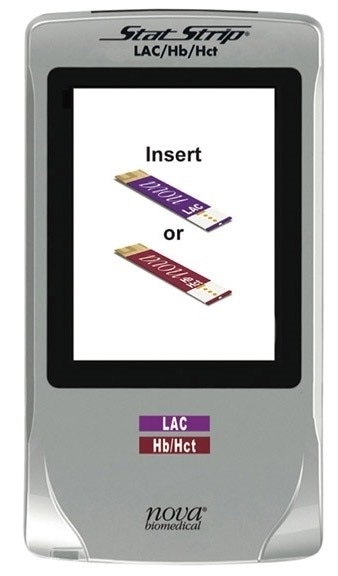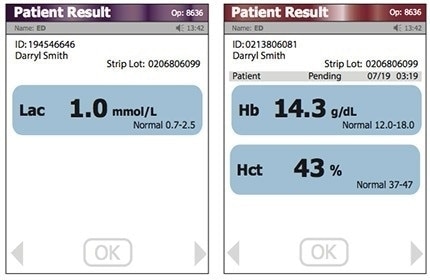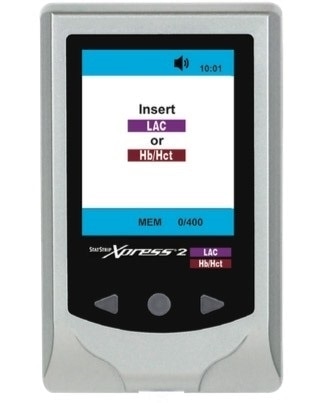Nova Biomedical has introduced a portable and user-friendly meter system, called StatStrip Lactate and Hemoglobin/Hematocrit Meter system (StatStrip LAC/Hb/Hct). The system measures Hb, Hct, and LAC at the point of care by using a pair of disposable biosensors and small capillary blood specimens for all kinds of tests.
The lactate biosensor in the StatStrip system delivers lab-like precision in only 13 seconds from just 0.6 µL of capillary blood. Similarly, the Hb/Hct biosensor in the StatStrip system can precisely measure — not calculate — both Hct and Hb in just 40 seconds from a 1.6 µL capillary sample.
- Lab-like precision
- Rapid results as fast as 13 seconds
- A pair of disposable, pre-calibrated biosensors: Hemoglobin/hematocrit and lactate
- Capillary fingerstick blood samples as small as 0.6 μL
Lactate, hemoglobin and hematocrit
Lactate testing bedside
Being a point-of-care (POC) system, the StatStrip LAC/Hb/Hct allows fast and timely trending of lactate in hypoperfusion during sepsis (or other hypoperfusion conditions) for treatment efforts or assessment of resuscitation.
Testing with blood gas analyzers often involves arterial samples, extended analysis times (up to 2.5 minutes) and large sample volumes (up to 95 μL). By contrast, the single-use biosensor in the StatStrip offers the fastest turnaround time of 13 seconds on the tiniest whole blood sample of 0.6 μL with excellent correlation to central laboratory reference techniques.
Image Credit: Nova Biomedical
Solves lactate pre-analytical issues
Lactate is generally unstable in whole blood specimens. If samples are transported or stored at room temperatures, blood lactate levels will peak in less than 5 minutes.1 The StatStrip point-of-care assures fast, precise results by preventing the pre-analytical effects of sample transport.
Hemoglobin and hematocrit testing bedside
The StatStrip LAC/Hb/Hct is the only POC system to offer screening and monitoring of anemia with measured, not calculated, Hct and Hb tests. This major innovation was possible due to the latest, patented biosensor technologies devised by Nova Biomedical.
Image Credit: Nova Biomedical
Accurate assessment of anemia
Both measured Hb and measured Hct are required for the precise evaluation of anemia. However, existing POC Hb meters only offer a calculated estimate of Hct.
Calculated estimates of Hct are not accurate in several conditions, such as hemoglobinopathies, hemolysis, red cell structural abnormalities and other medical conditions. These conditions necessitate measured Hct because calculated results can have a negative effect on treatment.
Simple and safe testing
The StatStrip single-use biosensors are similar to glucose self-testing but do not require calibration or coding. A biosensor ejector enables touch-free disposal and prevents a possible biohazard.
Three simple steps are involved in testing:
1. Insert a Hb/Hct or lactate biosensor into the meter
Image Credit: Nova Biomedical
2. Lance the finger to achieve blood drop
Image Credit: Nova Biomedical
3. Touch the biosensor on the blood drop
Image Credit: Nova Biomedical
Choice of two meters
StatStrip® LAC/Hb/Hct full connectivity meter
- On-board storage of 1000 patient results with positive patient ID
- Color touchscreen operation and results display
- Wireless or wired connectivity to NovaNet middleware, electronic medical records and third-party middleware
- Not available in Canada or the United States

Image Credit: Nova Biomedical

Image Credit: Nova Biomedical
StatStrip Xpress®2 LAC/Hb/Hct meter
- First-in/first-out storage of up to 400 test results
- Bright color result display and touch-sensitive buttons for operation
- No data transmission; time, date and sequential numbering for sample identification
- Not available in Canada or the United States

Image Credit: Nova Biomedical
Image Credit: Nova Biomedical
Smallest blood sample
The StatStrip biosensors use only a small amount of the blood needed by other point-of-care devices that quantify only hemoglobin or lactate and thus enable screening or monitoring of patients with minimal loss of blood.
- LAC — 0.6 µL
- Hb/Hct — 1.6 µL
Fast turnaround time
The StatStrip system offers fast turnaround time for hemoglobin, hematocrit and lactate, allowing rapid decision-making relating to anemia, sepsis and tissue hypoxia.
- LAC — 13 seconds
- Hb/Hct — 40 seconds
Smallest and lightest meters
The StatStrip LAC/Hb/Hct meters are lighter and more compact than other similar POC devices that quantify only hemoglobin or lactate. The StatStrip small, lightweight meters allow testing at the patient-side or bedside.
StatStrip LAC/Hb/Hct connectivity meter
- Weight: 220 g
- Size: 147 x 79 mm
StatStrip Xpress 2 LAC/Hb/Hct meter
- Weight: 78.5 g
- Size: 98.0 x 61.0 mm
Source: Nova Biomedical
Complete data connectivity with NovaNet
NovaNet is a single, economical bidirectional interface solution meant for StatStrip LAC/Hb/Hct connectivity meters to the LIS/HIS/EMR. More than 60% of hospitals in the United States now use NovaNet for connectivity and management of either the Stat Profile Prime Plus blood gas analyzers or the StatStrip Glucose meters from Nova Biomedical. Features include:
- Positive patient ID with three or more patient identifiers
- Industry-standard POCT1a-2, HL7, or ASTM interface formats
- Complete data security and encryption
Clinical applications
Lactate monitoring for sepsis management
Surviving Sepsis Campaign (SSC) suggests early lactate testing
The SSC Hour-1 Bundle comprises the following suggestions for early recognition and management of sepsis:
- Quantify lactate within the first hour of detecting sepsis
- Re-quantify lactate if the preliminary result is more than 2 mmol/L
- Guide resuscitation to standardize lactate in patients with increased levels, which is a marker of tissue hypoperfusion2
Image Credit: Nova Biomedical
Pre-hospital and emergency triage
The StatStrip LAC/Hb/Hct offers live, precise results when every second is crucial:
- A quick assessment of anemia (caused by injury, chronic illness or other blood loss) and dehydration
- A quick assessment of signs of sepsis and infection, trauma, internal injury and abdominal pain
Prenatal and Ob/Gyn
Almost 42% of pregnant women experience anemia in prenatal care. If anemia is left untreated, it can become severe, increasing the risk of low birth weight or premature birth of babies.3,4
The StatStrip helps clinicians:
- Modify treatment including supplements and nutrition
- Prevent and track anemia in pregnant women
- Measure scalp or cord lactate to detect or rule out fetal distress at the time of labor and delivery
Image Credit: Nova Biomedical
Blood bank
The StatStrip system offers the precision required to safely and effectively screen blood donors and prevent false deferrals:
- Portable for use in temporary or mobile blood collection sites
- Accurate over the whole measurement range of 6.5 to 22 g/dL Hb and 20% to 65% Hct
Dialysis
A common comorbidity in patients undergoing dialysis is anemia. Maintaining facility- and individual-level Hb/Hct guidelines are linked to reduced hospitalization and increased survival rates in this group of people.5,6
The StatStrip point-of-care testing:
- Offers quantitative data for EPO, anemia and iron therapy decisions
- Helps keep patients in clinically acceptable ranges

Image Credit: Nova Biomedical
Oncology
Chemotherapy-induced anemia (CIA) impacts about 83% of cancer patients.7 The StatStrip system offers real time Hb/Hct status required to proactively recognize high-risk patients for CIA and thus offer timely treatment.
* StatStrip Lactate/Hb&Hct meters are not available in the US and Canada, but StatStrip Lactate Connectivity meters can be used.
References
- Rollins G. The state of sepsis care. Clinical Laboratory News 2011;37(3):4.
- https://www.sccm.org/getattachment/SurvivingSepsisCampaign/Guidelines/Adult-Patients/Surviving-Sepsis-Campaign-Hour-1-Bundle. pdf?lang=en-US. Accessed 15 June 2020.
- Mayo Clinic. Iron deficiency anemia during pregnancy: Prevention tips. 15 Feb 2017.
- Townsley DM. Hematologic complications of pregnancy. Semin Hematol 2013;50(3):222-231.
- Hung S-C et al. Erythropoiesis-stimulating agents in chronic kidney disease: What have we learned in 25 years? J Formos Med Assoc 2014;113:3-10.
- Jing Z et al. Hemoglobin targets for chronic kidney disease patients with Anemia: A systematic review and meta-analysis. PLoS ONE 2012;7:e43655.
- Hwasoon R. Chemotherapy-induced anemia in cancer patients. OncoLink: 17 Jan 2012. Certifications and Compliance: Nova Biomedical is certified to FDA Quality System Regulations and ISO 13485:2016. Complies to IVDD Tested According to: EN 61010-1:2010, EN 61010-2-101:2015, EN 60825-1/A1:2007 *Nova Biomedical Patent Numbers: CA2846887A1 EP2568281A1 US8603309 JP5812957 US9535053B1 US8603309B2 US9638686B1 Nova Biomedical® is a registered trademark of Nova Biomedical Corporation.